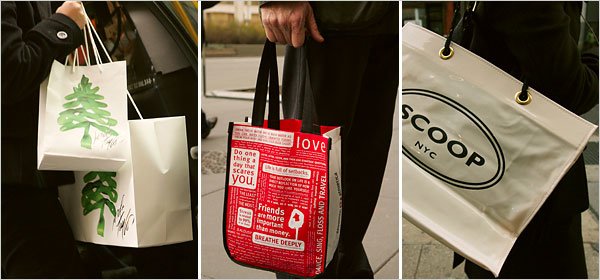Over at Bergdorf Goodman, staff members held secretive deliberations that stretched late into the night for nine months.
The focus of all this scurrying was not this fall’s couture line or next spring’s resort collection.
It was shopping bags.
Once a flimsy afterthought in American retailing — used to lug a purchase home from the store, then tossed into the trash — the lowly, free store bag is undergoing a luxurious makeover.
From upscale emporiums to midprice chains, retailers are engaged in a heated competition to make the most durable, fashionable shopping bags. They are investing millions of dollars in new flourishes like plastic-coated paper (Macy’s and Juicy Couture) and heavy fabric cord handles (Abercrombie & Fitch and Scoop).
Behind the battle of the bags is a significant shift in behavior that has turned consumers into walking billboards for stores. In cities like New York, Chicago and Los Angeles, customers have begun treating shopping bags as disposable purses that can be reused for weeks, if not months, to carry laundry to the cleaners, books to the beach or lunch to the office.
But only the best bags make the cut. So stores, sensing a marketing opportunity, are racing to transform bare-bones bags into lavish, thick ones that will become free advertising.
“It’s an unspoken goal,” said Terron E. Schaefer, senior vice president for marketing at Saks, which just redesigned its bags to be sleeker and heftier. “We want people to keep the bag.”
Increasingly, they do. After making a purchase at Lord & Taylor a few weeks ago, Allana Cummings, 19, of Irvington, N.J., said, she quickly adopted the chain’s newly redesigned bag, with its eye-catching white color and seemingly indestructible paper, as “my second purse.”
“I can put everything I need for the day in here and it will never break,” she said, opening the bag to reveal several wrapped gifts, a short stack of books, an umbrella and her real purse, an expensive leather handbag.
At first blush, the trend of reusable shopping bags would seem at odds with the explosive growth of high-end handbags. But it turns out that some consumers are eager to walk around with a $1,000 Coach purse on one arm and the Coach shopping bag it came in on the other.
“I often prefer this to my leather handbag,” said Kay Scouller, 34, standing on a Manhattan subway platform with a used Coach shopping bag in hand, filled with a tube of moisturizer, a pair of sunglasses and a bottle of water.
For decades, American retailers regarded shopping bags as little more than a utilitarian necessity — and the bags looked the part, constructed from cheap, unembellished paper or plastic. But by the late 1970s, the sturdy bags used by small European luxury brands like Cartier, the jewelry maker, began to appear in the United States.
A handful of big American companies, like Avon, the cosmetics company, experimented with paper bags reinforced with a thin layer of plastic in the 1980s, a radical departure. But it was not until the last several years that luxury bags began to trickle down to the average consumer, as chains like Victoria’s Secret, Banana Republic and Swatch tried to ape their fast-growing luxury rivals.
“The new part of this equation is that mass-market brands that are not necessarily luxury are using these types of bags,” said Claude Roessiger, chief executive of Pak 2000, which designs and manufactures shopping bags for brands like Cartier, Bulgari and Ralph Lauren.
Many grocery chains now sell extra-thick versions of their regular bags and encourage their reuse to cut down on waste, but what stands out about the newest crop of retail bags is that, despite their heft, they remain free.
For consumers, the sudden emphasis on “reusability,” as retail executives call it, is creating a surprising new hierarchy. Interviews across New York City suggest, for example, that shoppers covet the heavy-duty plastic bags from Lululemon Athletica, the seller of yoga clothing, above the thin paper version provided by the luxury department store Bloomingdale’s.
Chains are scrambling to move up the bag hierarchy. A year ago, employees at Lord & Taylor decided that their bags had become a liability. “It was the thinnest, most inexpensively constructed bag you could offer — a true throwaway bag,” said the chief executive, Jane Elfers.
So the retailer asked David Lipman, a marketing executive, to help design a new bag. Over six months, Mr. Lipman and his staff spared no expense. They eventually settled on a rich, white canvaslike paper — Mr. Lipman would disclose no further details — and thick, synthetic handles.
Designers obsessed over every detail. The white exterior extends into the bag’s orange interior one-sixteenth of an inch, no more, no less, and the words Lord & Taylor are embossed, rather than printed, a less expensive technique.
As a result, each large Lord & Taylor bag costs roughly 80 cents, more than twice the industry average. But that investment has paid off, turning the bag into one of the most popular.
“It’s a gorgeous bag,” said Mozel Browne, 75, who said she started saving Lord & Taylor’s shopping bags since the redesign this fall. “I could honestly give it away as a gift.”
Lord & Taylor’s bags threaten to upstage those of its glossier rivals, like the ultrachic Bergdorf Goodman, whose traditional lavender bags, emblazoned with the image of well-dressed Park Avenue ladies, are thin and frail by comparison. Its handles, for example, are taped on, rather than threaded through the bag and tied into a knot, as they are at Lord & Taylor.
Not to be outdone, Bergdorf has spent nearly a year secretly redesigning its bags, which will be introduced to consumers in fall 2008. Its goal? “Something with greater longevity than the existing bag — a keep-me quality that does not feel disposable,” said Aidan Kemp, vice president for advertising at Bergdorf.
To ensure that the bags are fashionable, Bergdorf employees surreptitiously photographed one another across Manhattan, holding prototypes “to see what they look like on the street,” Mr. Kemp said. The bag’s new look is under wraps, but Mr. Kemp acknowledged that the famous Park Avenue ladies may disappear.
Bloomingdale’s also appears to be under pressure to upgrade its bags, whose design dates to the 1970s. The chain says it is developing a thicker reusable bag to join its lineup of thin paper ones, which bear phrases like “Medium Brown Bag.”
For Bloomingdale’s and Bergdorf, the redesigns may be costly, but missing out on free advertising from beefed-up bags could prove even costlier. Jenny Fenig, a 30-year-old event producer in Manhattan, has reused the same Lululemon shopping bag to shuttle gym clothes around the city for three months.
“I love this bag,” she said. “It’s become an extension of my purse.”











